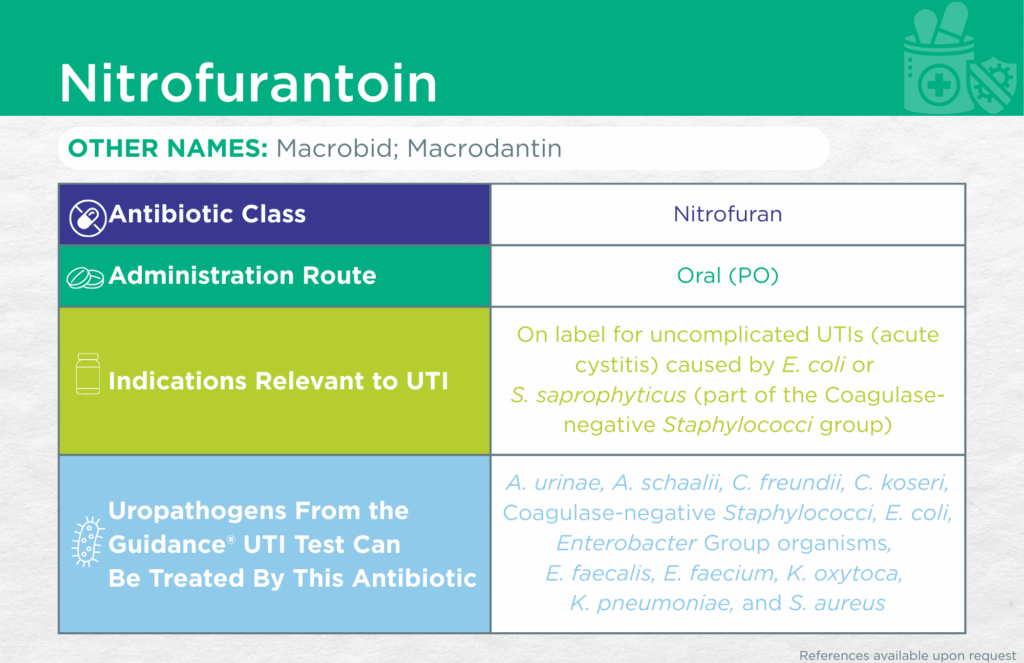Nitrofurantoin

Emery Haley, PhD, Scientific Writing Specialist
Nitrofurantoin
Find the Latest FDA-Approved Labelling Information Here: Drugs@FDA Online Database
Administrative Routes
Oral (PO)
Other Names
Macrobid; Macrodantin
Bacteriostatic or Bactericidal
Bactericidal [1]
Antibiotic Class
Nitrofuran
Mechanisms of Action
Nitrofurantoin acts through multiple mechanisms, which may be why bacterial resistance to nitrofurantoin remains limited.
Nitrofurantoin is taken up by bacterial intracellular flavoproteins that reduce nitrofurantoin to reactive intermediates. The intermediates inhibit the bacterial citric acid cycle, DNA and RNA synthesis, and protein synthesis, resulting in bacterial cell death.
WHO AWaRe Classification
Access [2]
Empiric Use Recommendations
Yes* (lower UTI/cystitis) [World Health Organization (WHO), American Urological Association (AUA)] [3-4]
*Avoid if there are signs/symptoms of early onset pyelonephritis
Avoid if complicated UTI is suspected, as nitrofurantoin may not achieve adequate levels in renal parenchyma and blood [Infectious Diseases Society of America (IDSA)] [5]
Indication(s) Relevant to UTI
On label for uncomplicated UTIs (acute cystitis) caused by Escherichia coli or Staphylococcus saprophyticus (part of the Coagulase-negative Staphylococci group).
Checkmarks
CLSI and/or FDA documents support the efficacy of this antibiotic against the following organisms from the Guidance® UTI test: Aerococcus urinae, Citrobacter freundii, Citrobacter koseri, Coagulase-negative Staphylococci, Escherichia coli, Enterobacter Group organisms, Enterococcus faecalis, Enterococcus faecium, Klebsiella oxytoca, Klebsiella pneumoniae, and Staphylococcus aureus.
Published primary literature supports the efficacy of this antibiotic against the following organism from the Guidance® UTI test: Actinotignum schaalii [6-7]
- Ishak, A.; Mazonakis, N.; Spernovasilis, N.; Akinosoglou, K.; Tsioutis, C. Bactericidal versus Bacteriostatic Antibacterials: Clinical Significance, Differences and Synergistic Potential in Clinical Practice. J. Antimicrob. Chemother. 2024, 80, 1–17, doi:10.1093/jac/dkae380
- AWaRe Classification of Antibiotics for Evaluation and Monitoring of Use, 2023 Available online: https://www.who.int/publications/i/item/WHO-MHP-HPS-EML-2023.04 (accessed on 6 February 2025).
- The WHO AWaRe (Access, Watch, Reserve) Antibiotic Book – Infographics – PAHO/WHO | Pan American Health Organization Available online: https://www.paho.org/en/documents/who-aware-access-watch-reserve-antibiotic-book-infographics (accessed on 22 July 2025).
- Recurrent Uncomplicated Urinary Tract Infections in Women: AUA/CUA/SUFU Guideline (2022) – American Urological Association Available online: https://www.auanet.org/guidelines-and-quality/guidelines/recurrent-uti (accessed on 6 February 2025).
- Complicated Urinary Tract Infections (CUTI): Clinical Guidelines for Treatment and Management Available online: https://www.idsociety.org/practice-guideline/complicated-urinary-tract-infections/ (accessed on 28 July 2025).
- Lotte, R.; Lotte, L.; Ruimy, R. Actinotignum Schaalii (Formerly Actinobaculum Schaalii): A Newly Recognized Pathogen—Review of the Literature. Clin Microbiol Infec 2016, 22, 28–36, doi:10.1016/j.cmi.2015.10.038.
- Cattoir, V.; Varca, A.; Greub, G.; Prod’hom, G.; Legrand, P.; Lienhard, R. In Vitro Susceptibility of Actinobaculum Schaalii to 12 Antimicrobial Agents and Molecular Analysis of Fluoroquinolone Resistance. J Antimicrob Chemoth 2010, 65, 2514–2517, doi:10.1093/jac/dkq383.
Dr. Emery Haley is a scientific writing specialist with over ten years of experience in translational cell and molecular biology. As both a former laboratory scientist and an experienced science communicator, Dr. Haley is passionate about making complex research clear, approachable, and relevant. Their work has been published in over 10 papers and focuses on bridging the gap between the lab and real-world patient care to help drive better health outcomes.